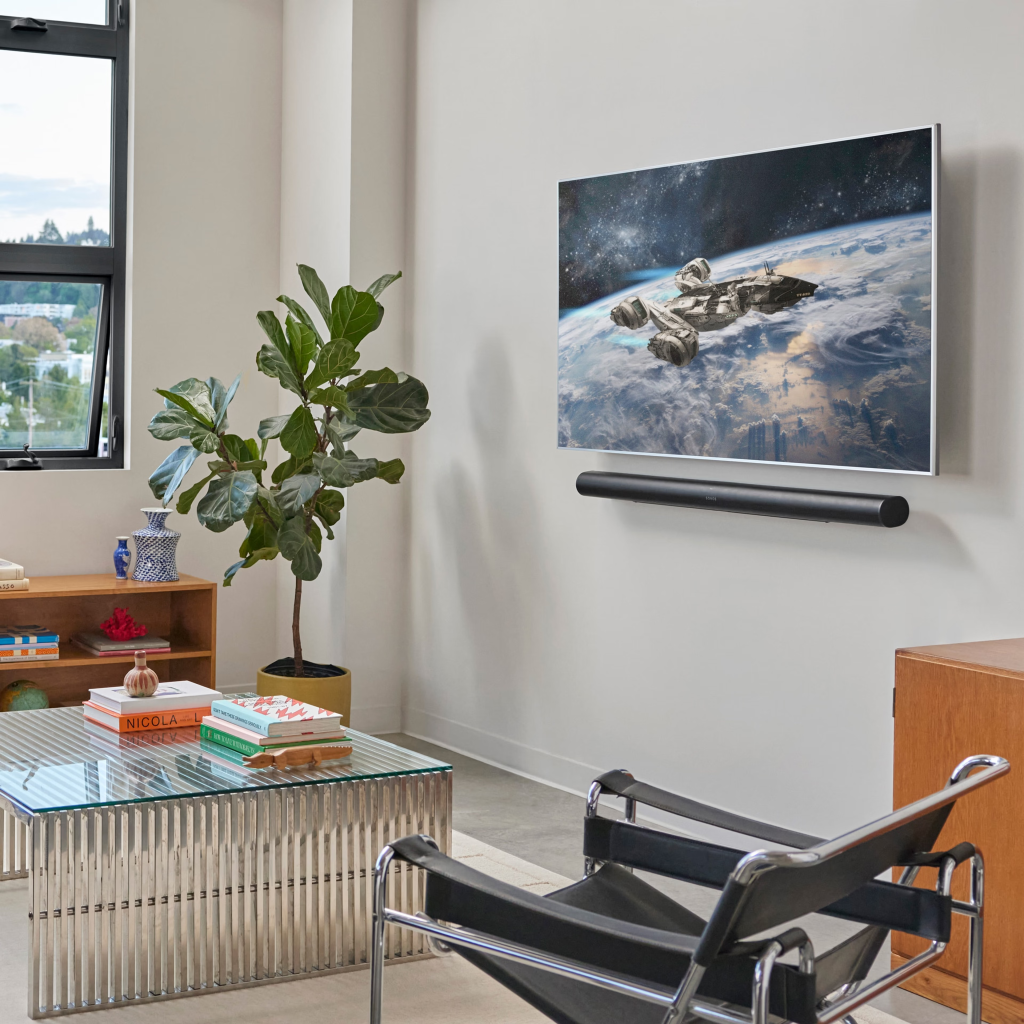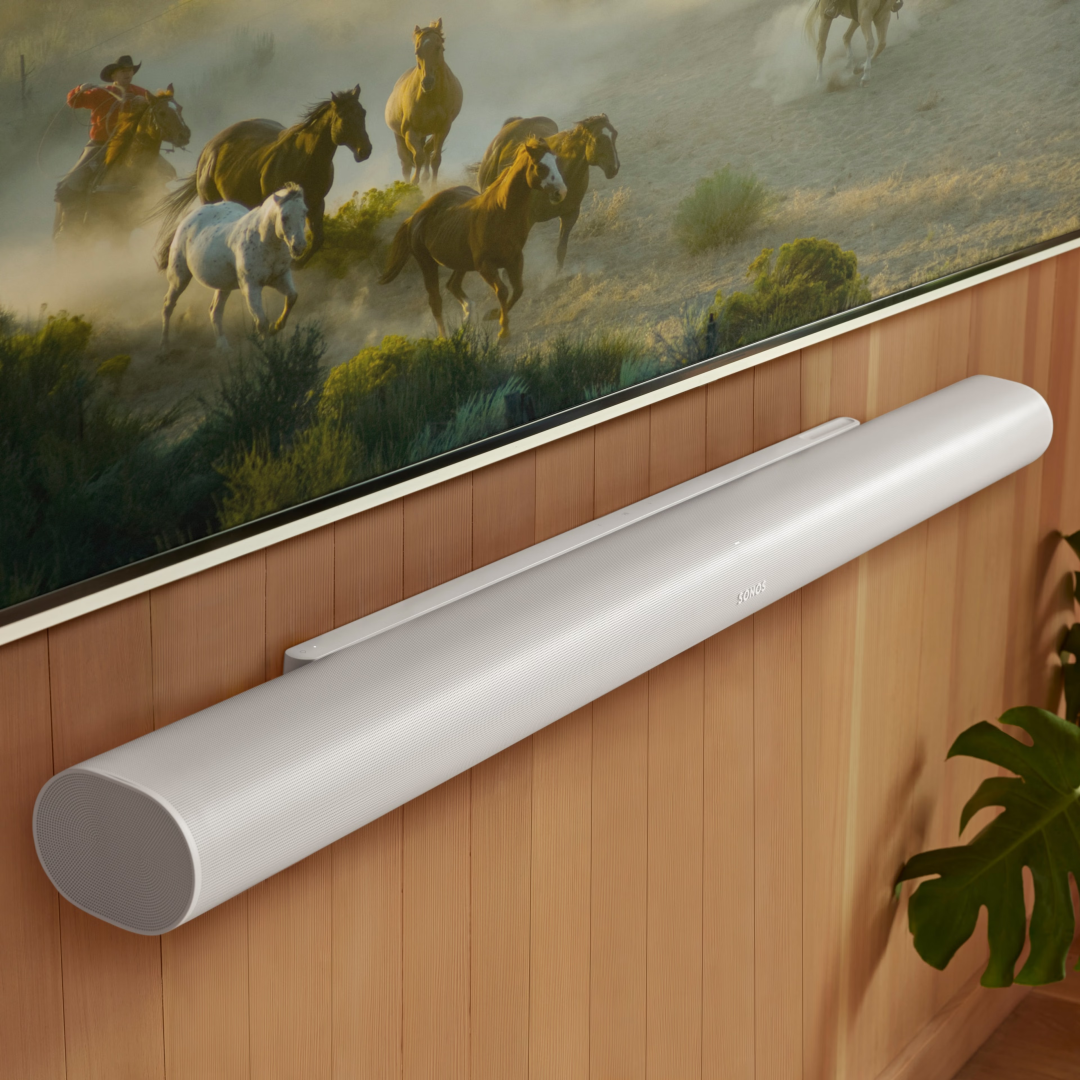The sound bar market has evolved rapidly, and Sonos has been one of the main drivers of that transformation. With the Arc Ultra, the brand presents an offering that seeks to establish itself as the most complete option in the all-in-one segment, without the need for additional components.
This analysis examines the actual performance of the Sonos Arc Ultra from a critical perspective, highlighting its advances compared to the previous model, but also pointing out its limitations. Is it an incremental improvement or a substantial change? Is its price justified compared to modular solutions? We address this in detail, evaluating both the design and the user experience and sound quality.
Design and Construction — Minimalist Style with Functional Improvements
At first glance, the Sonos Arc Ultra maintains the curved aesthetic of its predecessor, but with optimized dimensions: it’s a few centimeters lower, wider, and less deep. This allows for greater channel separation and a profile that doesn’t interfere with the TV screen. Its matte finish, available in white or black, reinforces the product’s discrete elegance.

The back now includes a renovated control panel, with more accessible capacitive buttons, a physical switch for microphones, and a Bluetooth pairing button. These small changes proved very useful in daily use, especially if wall-mounted. We liked how the new touch volume control feels: it’s easy to locate even in the dark.
Pros
More streamlined profile
Improved controls and easy access
Clean visual integration
Cons
The wall mount doesn’t perfectly align with the Arc Ultra’s dimensions. It may remain partially visible once installed.
Performance and Features — A Real Leap in Clarity and Immersion
The first thing we noticed when turning it on was the difference in how voices are projected. Even without activating dialogue enhancement, movie characters were heard with more body and presence. In our tests with action movies, we noticed a much wider sound stage, with effects that really seemed to move around the room.

The Sonos Arc Ultra transforms the acoustic heart of the previous model. It incorporates 14 drivers (compared to 11 in the Arc): 7 tweeters, 6 mid-range woofers, and 1 Sound Motion™ woofer, which translates to a true 9.1.4 configuration. This combination generates an immersive spatial sound that impresses even without an additional subwoofer.
The new tweeters improve the directionality of effects and the redesigned woofers now focus on mid-frequencies, leaving the bass to the innovative Sound Motion™, which offers double the bass power compared to the Arc. All this is backed by 15 Class D amplifiers.
Pros
Notable improvement in voice clarity and channel separation
Powerful bass without external sub
True Dolby Atmos 9.1.4 experience
Cons
No support for DTS: X or HDMI passthrough
High price compared to complete systems with subwoofer
Explore the Samsung Odyssey OLED G8 for a truly immersive audiovisual setup.
Autonomy and Intelligence — Software that Optimizes According to Your Space
During the first few days, we used Trueplay with iOS and then tested it with Android. In both cases, the result was sound adapted to the acoustics of our room: the bass felt more controlled and dialogue became clearer. The Sonos app is very intuitive, and we were able to adjust the equalizer according to what we were listening to (movies, podcasts, or music).
We activated Night Mode several times, and it effectively reduced explosions or harsh effects without losing detail. We also appreciated the voice enhancement, especially in content with uneven audio mixing.
Pros
Automatic or customized Trueplay depending on the operating system
Voice enhancement with adjustable levels
Streaming via WiFi, Bluetooth, or AirPlay
Cons
Not compatible with Google Assistant
Conclusion
After using it intensively, we can say that the Sonos Arc Ultra offers a very high-level sound experience without relying on additional accessories. If you have a large space and are looking for something simple, powerful, and elegant, this sound bar is ideal. But if you already have an Arc and your space isn’t very large, the improvement exists but may not be decisive.
What convinced us most was that each of the improvements is felt in practice: voices are clearer, effects more defined, and bass has presence without needing a subwoofer. It’s not a perfect sound bar nor for all budgets, but it is a firm step toward what a premium soundbar should be.
Technical Specifications
| Feature | Details |
| Dimensions | 1,178 x 75 x 110.6 mm |
| Weight | 5.9 kg |
| Audio configuration | 9.1.4 |
| Tweeters | 7 (including 2 upward-firing) |
| Mid-range woofers | 6 |
| Woofer | Sound Motion™ with dual membrane |
| Amplifiers | 15 Class D |
| Connectivity | HDMI eARC, WiFi 6, Bluetooth 5.3 |
| Voice assistants | Alexa, Sonos Voice Control |
| Trueplay compatibility | iOS and Android |
| Audio formats | PCM, Dolby Digital/Plus/TrueHD, Atmos |
| Colors | White, Black |
Alternatives
- Bose Smart Soundbar 900: Includes Dolby Atmos and TrueSpace technologies to create a surround sound environment without the need for rear speakers. Integrates the ADAPTiQ calibration system that adapts the audio to the acoustic conditions of the room. Offers connectivity via HDMI eARC, Wi-Fi, Bluetooth, and compatibility with voice assistants.
- Sony HT-A7000: Features a 7.1.2 channel configuration, 500W of power, and compatibility with Dolby Atmos and DTS:X. Incorporates 360 Reality Audio technology and connectivity via HDMI eARC, Wi-Fi, Bluetooth, USB, and optical. Allows expansion with subwoofers and rear speakers from the same series.
- Sennheiser AMBEO Soundbar Plus: Uses AMBEO technology to emulate a 3D sound experience without the need for additional components. Compatible with Dolby Atmos, DTS:X, 360 Reality Audio, and MPEG-H. Has HDMI eARC, Wi-Fi, Bluetooth, Apple AirPlay 2, and Chromecast connections. Includes automatic calibration according to room acoustics.
